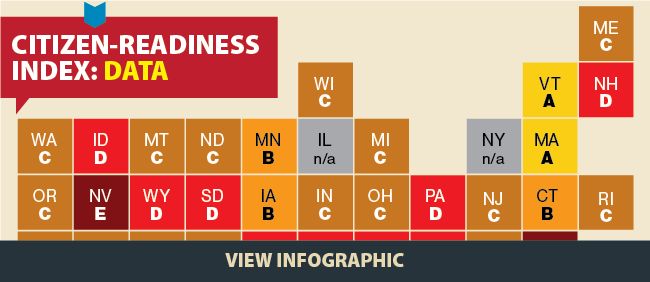- Fight Crime: Invest in Kids
- Mission: Readiness
- ReadyNation
- Champions for America's Future
- Shepherding the Next Generation
2016 Citizen-Readiness Index: Executive Summary
New data: Too many young Americans are unprepared for the workforce, unqualified for military service, or involved in crime.
Citizen-Readiness Index
Executive Summary
The economy, public safety, and national security are frequent talking points in this election season among candidates running for office, from the White House to the local level. But these conversations too often gloss-over a challenge underlying every significant sector of American society: a declining number of young adults who are ready to contribute to our nation—what we are calling “citizen ready”.
(See related infographic) Data shows that young Americans are struggling to become productive members of society on multiple measures. While today’s young adults are better educated than those of previous generations, 1 in 7 young adults ages 16 to 24 in the U.S. is not employed or in school.[1] In addition, more than a quarter of young adults have an arrest record―the majority drug-related.[2] And half as many young adults ages 18 to 32 are getting married compared to previous generations.[3]
These problems aren’t limited to a small proportion of the population. More than 70% of young adults ages 17 to 24 in the U.S. would not qualify for military service due to problems with obesity, education, drug abuse, or crime.[4]
Three Policy Priorities in 2017 to Improve Citizen-Readiness
This three-part report sheds light on this “citizen-readiness” problem across the country. Parts 1, 2, and 3 present concrete steps that Congress and the next president can take in 2017 to strengthen families, advance early education, and create healthier schools issues—solutions that can help America address its citizen-readiness problem. An infographic highlights key state-specific data on citizen readiness for each state.
Part 1: Strong Families To improve young adults’ workforce productivity and reduce their involvement in crime, Congress and the next president should support voluntary home-visiting programs by reauthorizing the Maternal, Infant, and Early Childhood Home Visiting (MIECHV) program.
Part 2: Early Education: By preparing children for success in school, high-quality early education improves future qualification for the workforce and military service while reducing crime. In 2017, Congress and the next president should prioritize targeted, high-quality early education and care, including by reauthorizing and improving the federal Head Start program, and providing needed support for both Head Start and the Preschool Development Grant program.
Part 3: Healthier Schools: Every sector of society relies on a healthy population, and the military in particular needs recruits who are fit and healthy. Congress passed the Every Student Succeeds Act in 2015 in an effort to address academic issues in America’s schools. However, schools still have a far way to go in providing healthy settings for children to learn good habits. In 2017, Congress and the next president should defend science-based nutrition standards for school foods, and states should reverse cuts to physical education (PE) programs.
Infographic: 50-state data measuring three indicators on citizen readiness.
Download report infographic
Download PDF summary
Read More About
States

